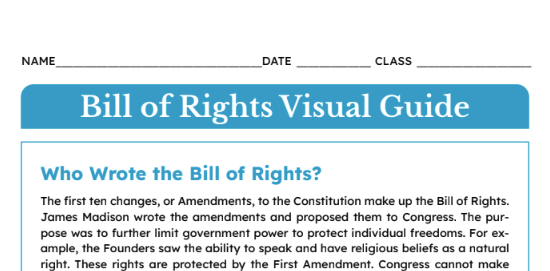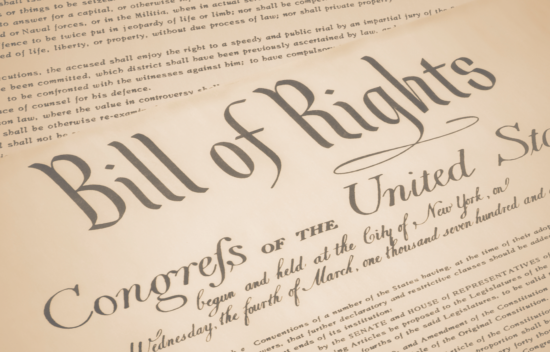
Grouping Rights
Guiding Question
- How do the amendments in the Bill of Rights protect individual liberties and limit government power?
Objectives
- Students will be able to recall the Bill of Rights amendments and categorize those into thematic groups.
Resources
Student Resources:
- Bill of Rights Visual Guide from BRI Jr.
- Bill of Rights: The 1st Ten AmendmentsBRI Primary Source
Engage
- Glossary term(s) for pre-teaching or targeted vocabulary support: bill of rights, amendments, constitution
- Ask students what they know about the Bill of Rights by having them complete a 3-2-1. Ask them for 3 words that come to mind when they hear “Bill of Rights”, 2 rights that are protected, and 1 question they have.
- Call on different students to share their 3s, 2s, and 1s with the class.
- If needed, remind students the Bill of Rights is the first ten amendments to the Constitution, the governing document of our nation.
- Tell students that they will be looking at these amendments and grouping them according to theme.
Explore
- Glossary term(s): individual rights, accused, limited government
- Divide students into three or six groups, depending on class size. Ideally, groups would be 3-5 students in each group.
- Give each group a focus area:
- One (or two depending on the number of groups) is Individual Rights
- One (or two depending on the number of groups) is Rights of the Accused
- One (or two depending on the number of groups) is Limited Government
- Transition: Tell students their task is to read through the amendments and use the visual guide to pick out the amendments they feel fit into their group’s amendment set.
- Give groups 15-20 minutes to read through the amendments and look at the visual guide either printed or digitally. As they read, they should discuss whether each amendment fits their set (Individual Rights, Rights of the Accused, or Limited Government)
- Have each group share their results-with any overlapping amendments, discuss where to settle keeping the amendment.
- For example, the limited government group may claim the first amendment because it says, “Congress shall make no…” However, the heart of the amendment is an individual’s right to free speech, religion, assembly, petition, and free press, so it’s better suited under individual rights.
- Settle on a class-categorized Bill of Rights that all students can record to study from.
- If visual guides were printed, you may choose to color code. If students are writing on a piece of paper, you may choose to have students make a chart. Alternatively, groups may make posters to be displayed in the room for all to see at any time.
Assess & Reflect
Option 1: Class Discussion Reflection:
- Ask students the following reflection questions:
- How do these categories help us understand the purpose of the Bill of Rights?
- How could we further break down the categories?
- Which amendment is most relevant to their lives today and why?
- Review your 1 question from the 3-2-1. Can you answer the question now? If not, either pose the question to the class or teacher to help find the answer.
AND/OR
Option 2: Exit Ticket:
- Display the reflection questions from Assess and Reflect option 1. Ask students to choose one to answer on a sticky note or blank piece of paper as a formative assessment.

